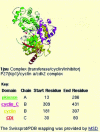The Pfam protein families database
- PMID: 14681378
- PMCID: PMC308855
- DOI: 10.1093/nar/gkh121
The Pfam protein families database
Abstract
Pfam is a large collection of protein families and domains. Over the past 2 years the number of families in Pfam has doubled and now stands at 6190 (version 10.0). Methodology improvements for searching the Pfam collection locally as well as via the web are described. Other recent innovations include modelling of discontinuous domains allowing Pfam domain definitions to be closer to those found in structure databases. Pfam is available on the web in the UK (http://www.sanger.ac.uk/Software/Pfam/), the USA (http://pfam.wustl.edu/), France (http://pfam.jouy.inra.fr/) and Sweden (http://Pfam.cgb.ki.se/).
Figures


References
Publication types
MeSH terms
Substances
Grants and funding
LinkOut - more resources
Full Text Sources
Other Literature Sources
Molecular Biology Databases
Research Materials
Miscellaneous

